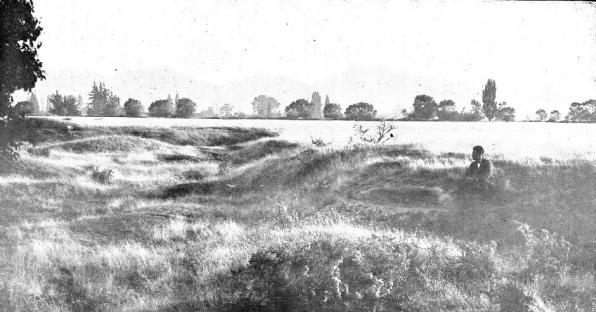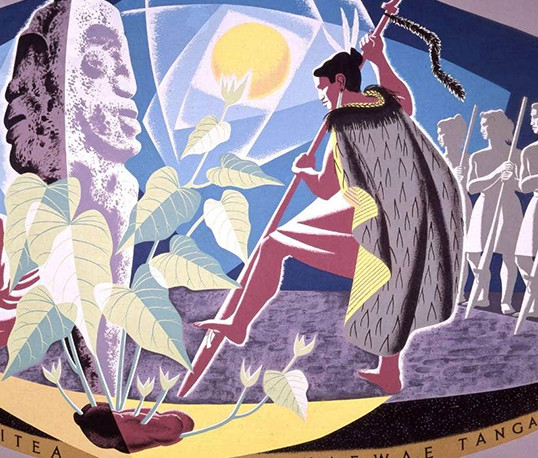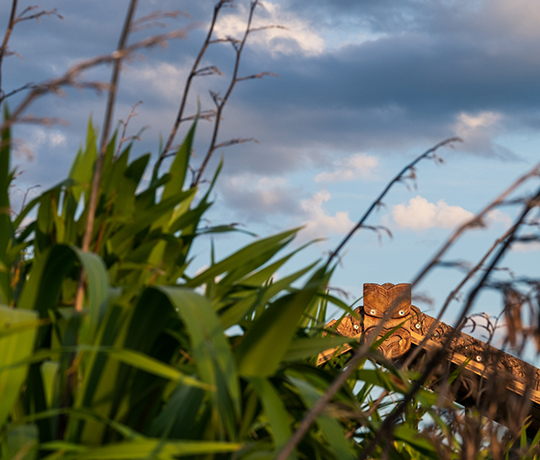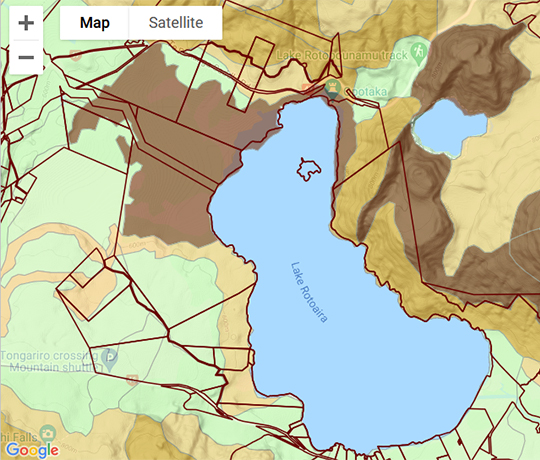Māori agriculture
Nahinga kai / Maara kai

Historic image of 'Māori gravel land and pits'. Source: Rigg & Bruce (1923) The Maori gravel soil of Waimea West, Nelson, New Zealand. The Journal of the Polynesian Society 32(126): 85-93.
Māori modified soils or Māori plaggen soils are extensive throughout Aotearoa-New Zealand (Best 1925; Singleton 1988; Harmsworth & Roskruge 2014a,b). Māori brought many warm tropical climate crops (e.g. taro, uwhi or yam, hue-gourde) to Aotearoa, and needed to manage the soils in the more temperate, colder climate in order for crops to grow well.
Evidence of soil modification includes features such as re-deposited mixtures of sand and gravel; stones; shell fragments; middens; natural fertilisers, seaweeds, wood/ash and charcoal from fires; garden walls, terraces, and mounds; relative levels of organic matter and effects from mulching or burning; garden implements such as the wooden kō used for digging, garden pits; and structures for storage.
In the Waikato region alone, Māori modified about 2,000 hectares of soil for growing crops, of which kūmara was the most important, with kūmara gardens located near rivers and on river terraces (Singleton 1988).
 Collective evidence provides insight into the past activities of indigenous Māori and indicates a progressive and developmental move towards gardening and horticultural practice, signalling an advancement in kaitiakitanga (guardianship) and maara kai (gardening). We know that gardening and cropping by Māori were significant around Māori communities and settlements (e.g.papakainga, marae, pā, maara kai, mahinga kai) in the 1700s and 1800s. Indeed, there is common belief among Māori that gardening practice and horticulture started when Māori arrived in Aotearoa and some evidence points to local gardens from the 1500s. Small garden plots are evidenced by large-scale modification of soils in many areas throughout Aotearoa-New Zealand.
Collective evidence provides insight into the past activities of indigenous Māori and indicates a progressive and developmental move towards gardening and horticultural practice, signalling an advancement in kaitiakitanga (guardianship) and maara kai (gardening). We know that gardening and cropping by Māori were significant around Māori communities and settlements (e.g.papakainga, marae, pā, maara kai, mahinga kai) in the 1700s and 1800s. Indeed, there is common belief among Māori that gardening practice and horticulture started when Māori arrived in Aotearoa and some evidence points to local gardens from the 1500s. Small garden plots are evidenced by large-scale modification of soils in many areas throughout Aotearoa-New Zealand.
Building on this early knowledge, there has been re-emergence and strengthening of Māori knowledge and Māori values to underpin soil and food management (Hutchings et al. 2018; Hutchings & Smith 2020), showing the significance of soils as a taonga (treasured resource) particularly at the local and community level, with demonstrated links to soil security, food production, healthy foods, and human well-being (Hutchings et al. 2018; Hutchings & Smith 2020; Harmsworth 2020, Stronge et al. 2020).
Soil Preparation and Kumara Growing
|
Preparation for growing kumara occurred in the autumn. Following burning of existing scrub or tree cover, large stumps were levered out by gangs of men. Lines of workers, each with a digging stick or ko, turned the soil. Roots and other debris were removed for burning. Kumara planting, an exclusively male activity, had to be completed within a day. Times of planting and harvesting were controlled by the stars and other favourable signs. Planting was done only on a fine day and each tuber was planted with its sprout facing north. Before planting the tohunga or priest invoked blessings of gods such as Rongo - god of peace and gardening, and Pani, the goddess who gave birth to the kumara. Planting was from October to December. From time of planting until harvest in March and April there was a tapu on the plantation. As the welfare of the tribe depended greatly on a successful kumara crop, error or infringement of tapu often resulted in death of the offender. Using manure was strongly repugnant to Maori, probably stemming from their belief that the Earth Mother, Papa, provided food, and it would be unwise to offend her by using something 'unclean'. Their agriculture was thus probably unique in that manure was never used as fertiliser. Manuka wood ash was used as a fertiliser on soils such as one matua (a firm loam) but not on friable, fertile soils. The use of gravel to build up a coarser layer on the original soil into which kumara were planted depended on soil type:
Maori were aware that clayey soils needed to be gravelled to improve friability. Why Maori should also gravel gravelly soils is unclear, but there are various suggestions put forward as shown in the diagram below.
|





|
Tamahere soils
Tamahere or Maori soils are sufficiently altered that they show distinct profiles.
 To the right is a profile of a soil which has been in rough pasture for about 60 years. The lower part of a ko (digging stick) is shown.
To the right is a profile of a soil which has been in rough pasture for about 60 years. The lower part of a ko (digging stick) is shown.
The length of the digging part of the ko corresponds approximately to the depth of the added gravelly topsoil (1), which may explain the irregular lower boundary of the soil horizon. The dark colour of the horizon probably originates from the accumulation of organic matter from (subsequent traditional) European farming practices.
No ash or charcoal is seen in horizon 2, confirming that wood ash was not used as fertiliser.
Horizon 3 represents subsoil that probably originated from a borrow pit.
The charcoal layer (horizon 4) contains wood ash, undoubtedly formed as the original topsoil surface was cleared by burning.
Horizon 5 is mainly made up of original subsoil. The streaks of black are from some buried topsoil.
The original subsoil can be seen in horizon 6.
The gravel bed (7) that underlies the soil would be made of material very similar to the gravel taken from the borrow pit





